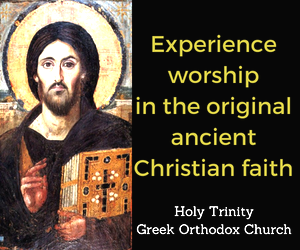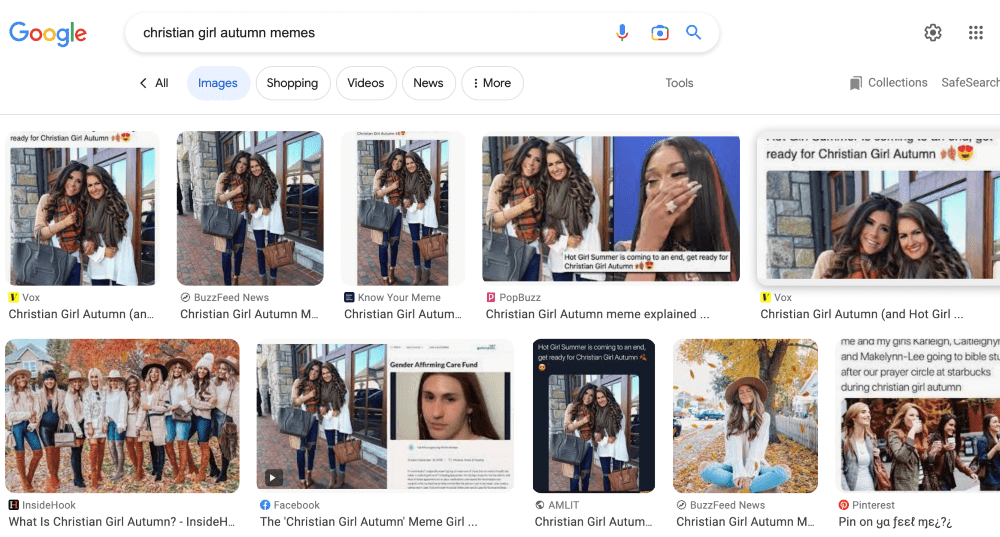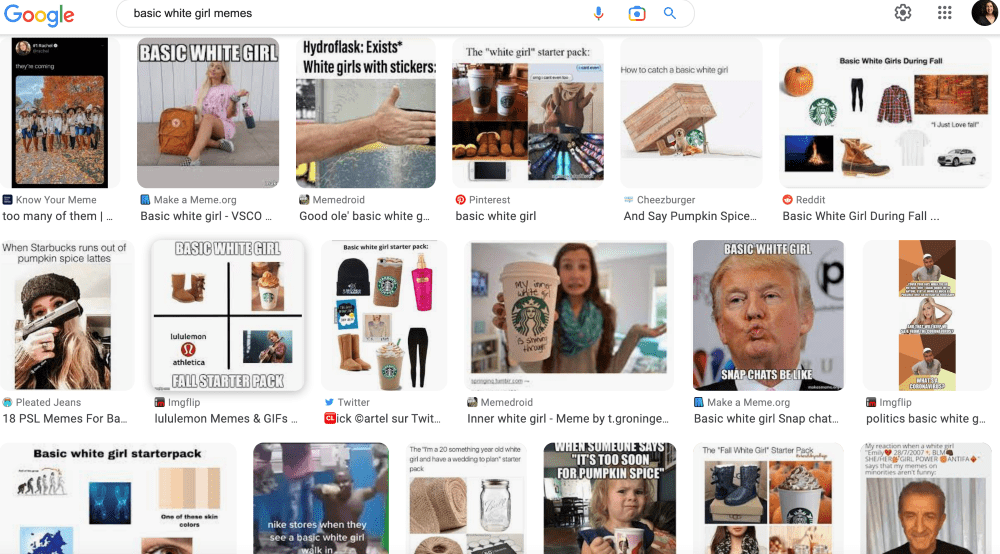Christian Girl Instagram Is More than a Meme
It showcases the beauty of creation, the rise of religious microcelebrities and how Christian women wield their authority and influence in digital spaces within traditional gender roles.
Guest Commentary by Ginger Monroe
Every year when autumn rolls around again, my side of the internet is bombarded with “Christian girl autumn” memes (see photos for reference). These memes come from the larger cultural phenomenon, which Christian comedian John Crist (who has since fallen from grace due to credible allegations of sexual assault) named “Christian Girl Instagram” in a 2014 YouTube video.
With a touch of sarcasm in his voice, Crist opens the infamous video with the line: “Are you a Christian girl that loves taking photos of her devotions?” The satirical video draws attention to the social media practices of mostly white Christian women. Sharing photos of devotionals, highlighted bible verses, Christian living books and, of course, multi-colored markers for note taking are just a few key features of the social media trend Crist makes fun of in his video.
This video was wildly popular in my own spiritual upbringing. I first saw it at my youth group, and continue to see these memes circulate each year (especially in the fall) nearly 10 years later.
As a teenager, I thought “Christian Girl Instagram” was hilarious. Mostly because somehow Crist could pinpoint, with chilling accuracy, the aesthetic of my Instagram account. I posted the devotionals, pictures of brightly-colored notes from Bible study or church, often with a steaming hot Starbucks latte in the background.
As I’ve grown older (and some may say smarter, maybe even wiser), I have grown skeptical of Crist’s video. Yes, it still highlights the peculiar way that white nondenominational Christian women use social media, but I have started to wonder if Crist is missing a valuable piece of the puzzle.
Now, a month past graduating with a Master’s of Theological Studies degree, I am less interested in laughing at these women (including my past self) and am more interested in understanding why and how such a large group of women have near-identical social media practices.
How have items like a pumpkin spice latte, an infinity scarf, and the color burgundy come to signify “I’m a white Christian woman!”? While it is easy to identify the items that signify “Christian Girl Instagram,” it is harder to articulate why they have that signification.
My hope is that I can provide context for these broader questions surrounding the role of Christian women engaging with digital media and popular culture. Moreover, I want to share a piece of my personal experience with “Christian Girl Instagram.” With that said, let’s begin: here’s what I think is going on behind the scenes of the (in)famous memes.
Instagram, Self-Representation and Aesthetics
Images have always been an integral part of human communication, predating written words. As social media has continued to grow throughout my life, images have become an important means of self-expression. We make choices about how we want to present ourselves for the consumption of others.
Media scholars Tombul and Sari write that social media is an “ideal world” where people create the persona they “yearn to become” to the world. When I shared pictures of my church notes or highlighted Bible verses to my Instagram story, it was because I wanted people to see: 1.) that I was being intentional about spending time with God, and 2.) how I saw God.
It didn’t matter that I wasn’t living up to the ideals that I posted about, so long as I showed the world that I was trying to be a good Christian.
The pursuit of portraying one’s ideal self within the “Christian Girl Instagram” aesthetic is not separate from the theological study of Christian aesthetics.
Miikka E. Anttila’s introduction to Christian aesthetics explains that for the Christian, the doctrine of creation calls one to notice the beauty in the world, even when it is not apparent. To neglect the beauty in the world would be to neglect the goodness of God’s creation.
Therefore, the practice of sharing beautiful moments in life — like autumn leaves, calligraphy of Bible verses or even a pretty outfit — shows commitment to the belief that attention to beauty is a form of worship.
In my personal experience, when sharing hiking photos, I would make sure that my caption reflected my belief in the goodness of creation, using song lyrics like “staring at the beauty of my King” from Bethel Music.
Christianity and Popular Culture — Networked Theology Religious Microcelebrities
“Christian Girl Instagram,” I argue, emerges from the larger culture of Christian microcelebrities on social media.
Kate Bowler’s book “The Preacher’s Wife: The Precarious Power of Evangelical Women Celebrities” offers a historical look at how women in “megaministry” spaces have found a way to monetize what they believe to be their roles as women such as being a wife, mother, host, etc.
Many of these attributes are visible within the “Christian Girl Instagram” sphere online, such as in the content of Christian microcelebrity and influencer Jordan Lee Dooley. She primarily shares pictures of herself, her husband, their baby and their dog, accompanied by inspirational or faith based captions.
By sharing her role as a woman and wife on her Instagram, she has gained the platform to become a bestselling author, the owner of a successful company — Soul Scripts — and has also taught entrepreneurship classes for women.
As a Christian microcelebrity, Dooley sets an example for how other Christian women ought to conduct themselves online, and I certainly did just that as a teen and young adult. I wanted my Instagram account to communicate a very specific message: that I am a Christian woman who loves the outdoors, coffee, my dog, church-going and multi-colored markers.
I already told you I believe that a piece of the puzzle is the ability to capitalize on traditional gender roles, but underlying that puzzle piece is women claiming religious authority in digital spaces because, like Gaddini argues here, the larger culture of Christianity doesn’t always allow women to wield their authority in the same way.
In constructing a digital space to interact with other Christian women, where they can be vulnerable and self-disclosing, Bowler would argue that these women have carved out a space of religious authority without putting themselves in direct competition with male pastors.
From this point of view, the emergence of “Christian Girl Instagram” starts to click into place. Women seeking a place to find their voice find social media, a new territory (or at least relatively new in 2014 when the memes began) in which they can share their faith with newfound authority.
The Meme-ification of Christian Girl Instagram
When I was 14, I dressed up as a “basic white girl” for Halloween: my costume complete with bedazzled PINK yoga pants, Ugg boots and a Starbucks latte.
The “Christian Girl Instagram” trend, then, may just be a repackaging of cultural products and ideas that could also be labeled as belonging to the “basic white girl” category.
In the same way that “basic white girl” was codified by these items of my youth, “Christian Girl Instagram” has become associated with its own list of cultural artifacts. It is, in a sense, a rebranding of what we now refer to as the (secular) “it girl,” with a Christian spin.
The meme-ification of “Christian Girl Instagram” comes into play when its overlap with secular culture is pointed out. It’s well known that the patriarchal world we live in will often make fun of what women stereotypically like: pumpkin spice lattes, Ugg boots, “The Twilight Saga,” etc.
So, when comedian Crist pokes fun at “Christian Girl Instagram,” perhaps he is making a larger statement about white women as an entire group, not unlike Bo Burnham’s song “A White Woman’s Instagram” from his Netflix original, “Inside.”
In my role as a scholar of religion and social media, I see “Christian Girl Instagram” the same way I see the “basic white girl,” or Burnham’s “A White Woman’s Instagram” — each model of womanhood has been meme-ified in some way, shape or form, speaking more to the culture we exist in than the women’s practices themselves.
And while I still find myself laughing at the “Christian Girl Autumn” memes as they start to circulate every fall, I also find myself pausing to consider where these memes came from and how they are an excellent case study of how Christianity interacts with digital media and the public sphere.










